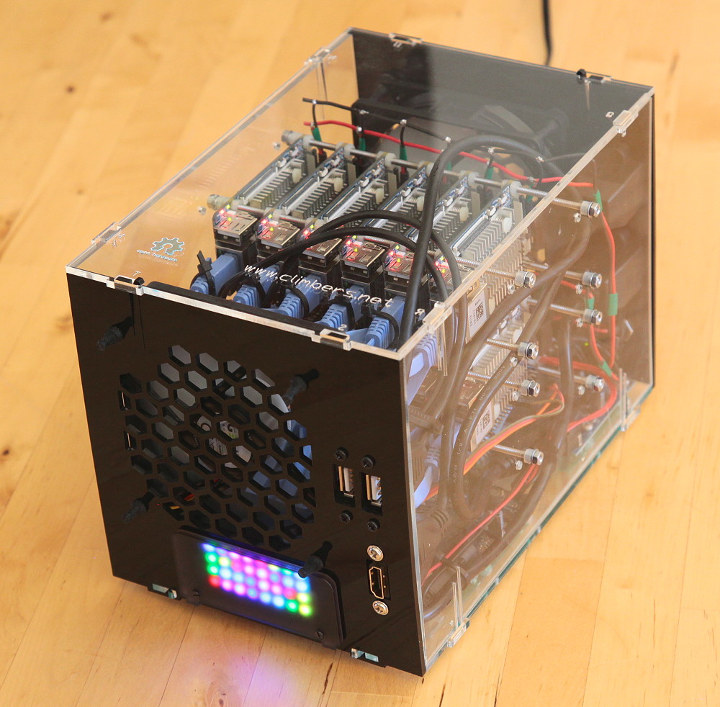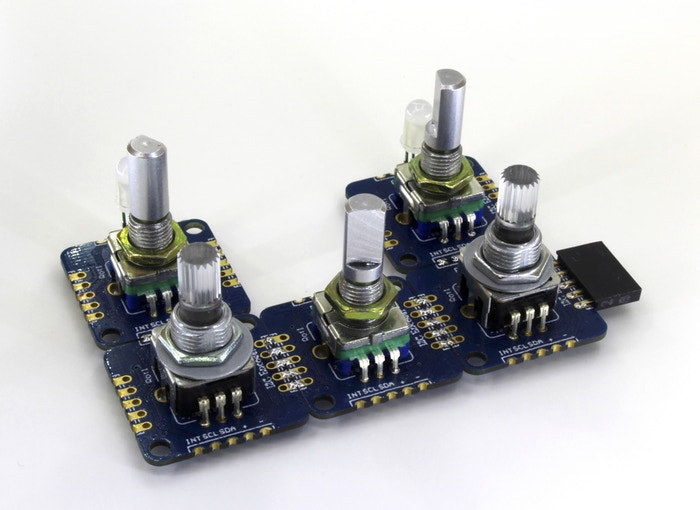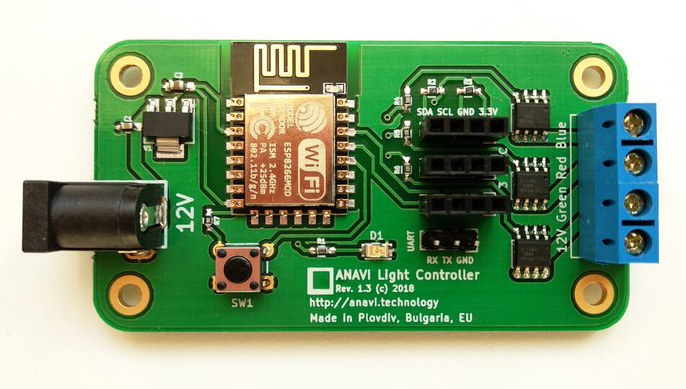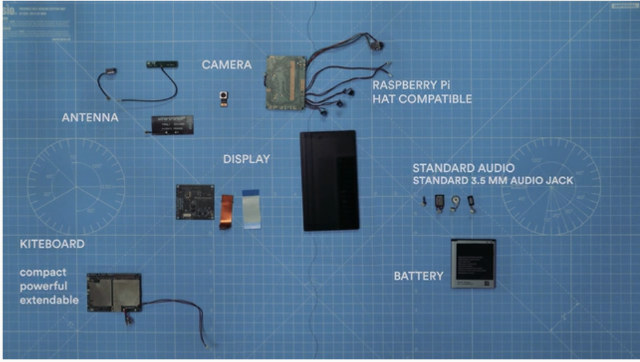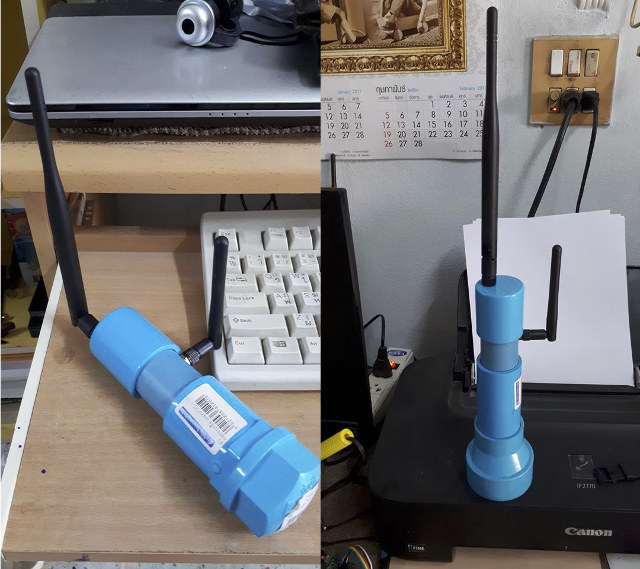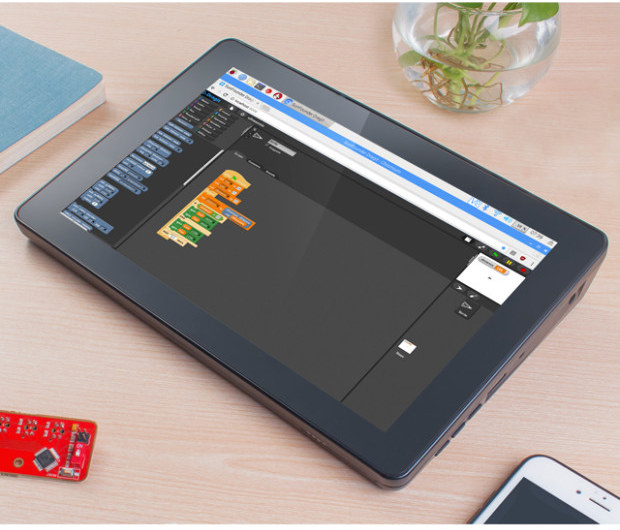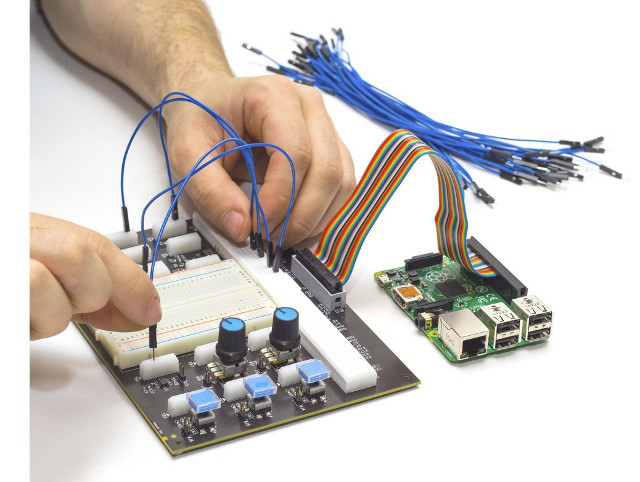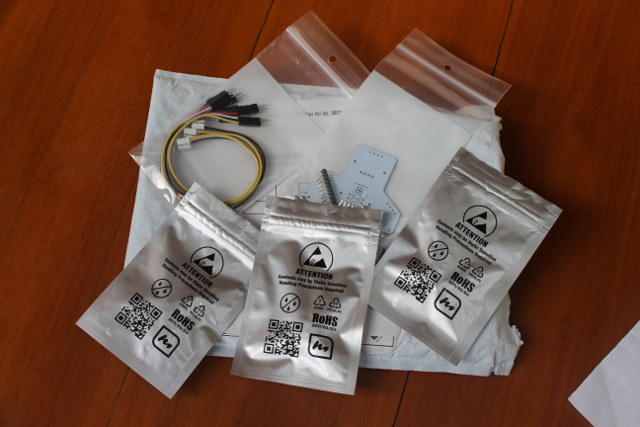Nick Smith has been messing around with clusters made of Arm boards for several years starting with Raspberry Pi boards, including a 5-node RPI 3 cluster, before moving to other boards like Orange Pi 2E, Pine A64+, or NanoPC-T3. His latest design is based on twelve NanoPi Fire3 boards with 8 cores each, bringing the total number of cores to 96. The platform may not be really useful for actual HPC applications due to limited power and memory, but can still be relied upon for education and development, especially it’s easily portable. Nick also made some interesting points and discoveries. It’s pretty with shiny blinking LEDs, and what looks like proper cooling, and the cluster can deliver 60,000 MFLOPS with Linpack which places it in the top 250 faster computers in the world! That’s provided we travel back in time to year 2000 through 🙂 By today’s standard, it would […]
Connect Multiple Rotary Encoders to Arduino, ESP8266, Raspberry Pi, etc… with I2C Encoder V2 (Crowdfunding)
Rotary encoders are pretty common devices that convert the angular position of a shaft to analog or digital output signals with quadrature-encoded A / B pulses the most common way of reporting the position to the micro. So for each encoder you’d need 2-pin, and if your project use many of those you may quickly run out of pin, interrupts, etc… Simone Caron has decided to tackle this issue by creating an I2C encoder board, which works with various encoders, and whose second revision is now offered on Kickstarter. The I2C Encoder V2 board supports standard mechanical encoders, illuminated RGB encoders, and clickable rotary encoders, each of which may be with or without dent. The board also comes with 3 GPIOs following RGB LED footprint, but also usable as PWN, GPIO, or ADC, and each board’s I2C address can be configured with some soldering on A0 to A6 pins. Finally, […]
ESP8266 based ANAVI Light Controller can be Programmed with Home Assistant or the Arduino IDE (Crowdfunding)
ANAVI Technology previously launched a Light pHAT allowing for RGB Light strip connection to Raspberry Pi boards, and during my review of ANAVI Light pHAT with Raspberry Pi 2, it did the job, but if that’s all you want to do, the Raspberry Pi board is clearly oversized & overpowered for the job. So Leon ANAVI got back to the drawing board and designed a similar open source hardware board – called ANAVI Light Controller – with an built-in ESP8266 module that removes the need for a fully fledged Linux board. ANAVI Light Controller specifications: Wireless Module – ESP8266MOD module based on ESP8266 Tensilica L106 32-bit processor Connectivity – WiFi 802.11 b/g/n Expansion Terminal block for 12 V RGB LED strip 3x I2C headers for sensors Debugging – UART header Misc – Button Power Supply – 12 V via power barrel jack Dimensions – 75 mm x 40 mm Certification […]
Kite is an Open Source Hardware Android Smartphone Powered by Snapdragon 450 Processor (Crowdfunding)
Kite is an open source hardware Android phone kit specifically targeting makers which you can assemble yourself into a Kitephone. The phone is based on a Qualcomm Snapdragon 450 mainboard (Kiteboard v2), and comes with a 720p touchscreen display module, a 12MP camera, antennas, buttons, a 3,000 mAh battery, and a Raspberry Pi HAT compatibility board to optionally interface to external hardware. Kiteboard v2 specifications: SoC – Qualcomm Snapdragon 450 octa-core Arm Cortex A53 @ 1.8 GHz with Adreno 506 GPU System Memory – 2 GB RAM Storage – 16 GB storage + microSD card slot Connectivity Cellular LTE Cat. 6/3G/2G, 2x nano SIM slots (dual-SIM dual standby) Two variant North America with LTE FDD Bands: 2,4, 5, 7, 12, 13, 14, 25, 26 LTE TDD Bands: 41 WCDMA 850, 1700, 1900, 2100 GSM 850, 1900 Rest of the World (Europe, Russia, etc…) LTE FDD Bands: 1, 3, 5, 7, […]
Making a DIY Case Out of PVC Pipes & Fittings for Electronics Projects
If you’ve ever visited Thailand, you may have noticed blue PVC pipes that are for water supplies, and usually visible since most of the time they are not placed underground. The pipes and fittings are very cheap, easy to find, and one person found out those could be used to make DIY cases for electronics projects. The two specimen above are a LoRaWAN node & gateway. The former is based on ESP07(ESP8266) module and RFM95W LoRa 868/915Mhz RF transceiver module, together with battery and sensors, while the latter is 1-channel LoRaWAN gateway or repeater, but I could not find the full details of the hardware design. I find that’s a clever idea, the design is pretty neat, and not everybody owns a 3D printer. An additional benefit is that it should be suitable for waterproof cases by adding some pipe glue to the unmovable parts, and a PVC screw cap […]
RasPad is a Tablet Kit for Raspberry Pi 3 B+ and Other Development Boards (Crowdfunding)
Many people interesting in coding and working on projects with the Raspberry Pi just likely connect the board to a monitor, USB keyboard and mouse, and to a power adapter, but if you are interested in having some more compact and portable RasPad tablet kit may be for you. The kit is compatible with Raspberry Pi boards, including the latest Raspberry Pi 3 B+, as well as other Arm/x86 Linux development boards including Tinker Board, LattePanda or BeagleBone Black. [Update: The design likely only works with RPi form factor, so if you use other boards with HDMI output, you may have to leave them out of the housing] RasPad key features: Display – 10.1″ IPS touch screen Video – HDMI port Audio – 2W speaker, audio jack Misc – 3 buttons (volume/brightness +, volume/brightness -, power), micro “USB touch” port Battery – Good for about 3 hours Power Supply – […]
EveLab 1.0 is an Advanced Breadboard Solution Designed for the Raspberry Pi
While it’s perfectly feasible to connect the Raspberry Pi board to a breadboard it can become relatively messy if your projects needs many I/Os due the wire and extra components like resistors, so “Robot In A Can” designed a circuit trainer for the University of Guelph students to wire projects with the Raspberry Pi’s (26-pin) header in a neater way, and made it durable to to endure years of use in a lab setting. The developer has now started selling the hardware, and called it EveLab 1.0. Evelabs 1.0 specifications: 2x 32×4 breadboards with markings for GPIO pins 1x “standard” breadboard 3x LEDs (pre-grounded) 3x Momentary Switch (pre-grounded) 2x Potentiometers (pre-grounded) 1x RGB LED (pre-grounded) 1x Analog to digital converter (2-inputs pre wired) 1x Light Sensor 1x Temperature Sensor The board also comes with 2 GPIO ribbon cables to connect to various Pi models, and 20 Jumper cables. The target board […]
Getting Started with TinyLIDAR Time-of-Flight Sensor on Arduino and Raspberry Pi
TinyLIDAR is an inexpensive and compact board based on STMicro VL53L0X Time-of-Flight (ToF) ranging sensor that allows you to measure distance up to 2 meters using infrared signals, and with up to 60 Hz. Contrary to most other VL53L0X boards, it also includes an STM32L0 micro-controller that takes care of most of the processing, frees up resource on your host board (e.g. Arduino UNO), and should be easier to control thanks to I2C commands. The project was successfully funded on Indiegogo by close to 600 backers, and the company contacted me to provided a sample of the board, which I have now received, and tested with Arduino (Leonardo), and Raspberry Pi (2). TinyLIDAR Unboxing I was expecting a single board, but instead I received a bubble envelop with five small zipped packages. Opening them up revealed three TinyLIDAR boards, the corresponding Grove to jumper cables, and a bracket PCB for […]


